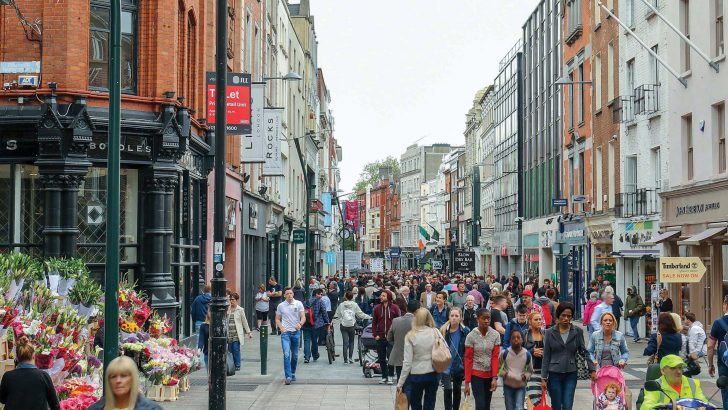Our population is boosted by young migrants, but we are still aging rapidly and declining sharply, writes David Quinn
Last year, almost 4,000 fewer babies were born in Ireland than in 2019. This is partly a Covid-effect. Countries around the world have experienced a bigger than usual fall in their birth rates, presumably because of lockdown and fewer opportunities to meet people.
We can expect an even bigger fall this year, because of the continuation of lockdown and thousands of couples postponing getting married, and presumably further delaying starting families as well.
There might also be an abortion effect. Surprisingly (to me at any rate), Scotland had the second highest number of abortions ever last year, more than 13,000 in a population similar in size to Ireland, despite lockdown.
But fertility in Ireland is declining anyway, as it is in much of the world. It has dropped well below replacement level which is 2.1 children per couple, meaning that to keep your population stable, every 20 couples must have 21 children.
The fertility rate in Ireland is now around 1.7 per couple. Amazingly, this is still one of the highest in Europe, and it is almost certainly boosted by the number of young migrants living here. But it is still below what we need to keep our population from ageing rapidly and declining sharply in the coming decades without massive amounts of inward migration.
Lowest rates
The lowest fertility rates in the world are to be found in Europe and East Asia. Just last week, China announced that married couples could now have three children. In 2016, it dropped its notorious one-child policy, which punished couples who had more than one child and sometimes forced women to have abortions. This terrible, inhuman policy never attracted the international attention it deserved probably because many people believed China should keep its population under control by any means.
China
The dropping of the policy in 2016 has not raised the birth rate in China by the desired amount, so now the government has said three children per couple is permitted. It is extremely doubtful this will have much impact either, without massive Government intervention. Chinese people have grown used to having just one child, and the cost of raising children, especially in cities, has soared.
It is now forecast than unless China can somehow reverse the situation its population will decline from around 1.4 billion people today, to around 732 million by the end of this century. And it will be much older too.
The picture is as bad in other East Asian countries. The populations of South Korea, Japan and Taiwan are also projected to fall by at least half.
The outlook in Europe is also terrible. Ireland’s population is actually forecast to grow a little to 5.44 million by the turn of the century, mostly because of immigration.
But Italy’s is set to halve, even with immigration. So is Spain’s. France will remain stable, presumably because of very high immigration and a high number of births among Muslim and sub-Saharan African migrants.
The average age of people in most European countries will soar. There will not be enough young people of working-age to support all the retirees.
But in Africa, the number of people is projected to sky-rocket. For example, the population of Nigeria is expected to grow from 200 million today to almost 800 million by 2100, meaning it will have overtaken China.
The Indian population by then is expected to be about 1.1 billion, somewhat down on today.
We hear an awful lot about the dire effects of climate change, and when we hear about population change it is mainly in connection with the harm it does to our climate. We are also accustomed to hearing that the world’s population is going to grow and grow.
But now it is believed that the number of people on the planet will peak at around 9.7 billion in 2064 and fall to 8.8 billion by 2100. This is 2 billion lower than previous UN estimates.
Distribution
There will still be a lot of people, but the distribution of population will have changed drastically, with big falls in Asia and Europe, and a big increase in Africa. Presumably many Africans will emigrate to Europe, and maybe to Asia.
What will it be like to live in a society where people are much older than today? It will be unimaginably different. For all of history, there have been many more young people than retirees. That has meant old people can be supported.
What happens if this is no longer possible? What will life be like in regions where the relatively few young people have gone to live in areas where there are more young people?
In the West of Ireland, this was a familiar pattern during periods of very high emigration. In parts of Germany and Italy it is familiar now. In fact, in some parts of Germany they are demolishing houses because there aren’t enough people to live in them.
In parts of South Korea there aren’t even pupils for the schools. In Japan, more incontinence pads for the elderly are made each year than nappies for babies.
Will the pressure to euthanise the elderly grow?
Can anything be done about any of this? Environmentalists will probably welcome what is coming because they see people as harmful to the planet. But as we decarbonise the economy over time our impact will become less harmful. Meanwhile, huge suffering will be caused by the imbalance between the number of elderly and the number of youth.
We need to look at making our economies far more family-friendly. That is, we need to pump money at young people wishing to have children. We need to help them with the cost of education, accommodation, childcare (by which I don’t simply mean day-care).
Above all, we need to start debating the issue in the same way we debate the environment, because at present we are sleep-walking into what will undoubtedly be a nightmarish demographic situation.


 David Quinn
David Quinn
